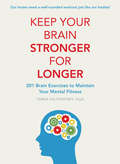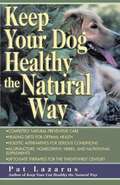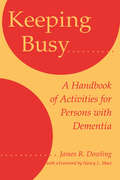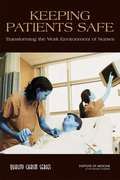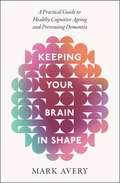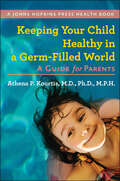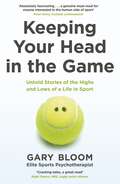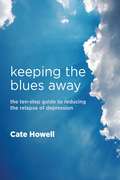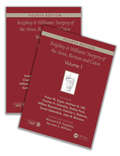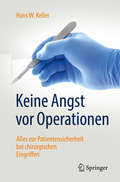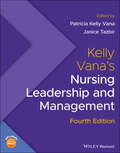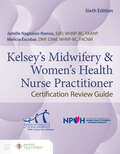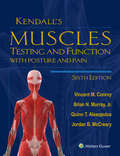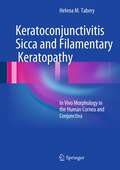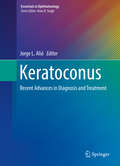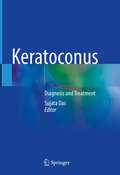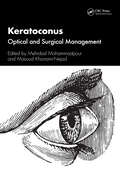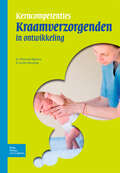- Table View
- List View
Keep Your Brain Stronger For Longer: 201 brain exercises to maintain your mental fitness
by Tonia VojtkofskyOur brains need a well-rounded workout just like our bodies!Research has shown the benefits of keeping our mental abilities strong, and those who challenge their brains throughout their life have a lower risk of developing dementia and cognitive impairment.Tonia Vojkofsky PsyD – a specialist in treating Alzheimer’s and dementia – has put together a variety of fun exercises to challenge the full range of your cognitive functions, from memory and reasoning to language and visual-spatial skills.Start at the beginning and work your way through, or pick and choose which exercises you want to do each day – you’ll see which cognitive ability you are exercising, allowing you to learn about the workings of your brain along the way.This book is a fun way to promote brain health, and empowers people to have influence over their future.
Keep Your Dog Healthy the Natural Way
by Pat LazarusMillions of people who use holistic techniques on themselves are now discovering they can apply these same powerful practices to their canine companions for a longer, healthier life.
Keepers of the Soul: The Five Guardian Elements of Acupuncture
by Nora FranglenThe five elements - Wood, Fire, Earth, Metal and Water - are fundamental to Chinese medicine and metaphysics, but it can be difficult to get beyond the purely intellectual level of understanding. This rich book gets to the heart of five element theory, and offers passionate reflections on the spirit of each element, and the practice of five element acupuncture. The author provides accessible accounts of each element, explaining what it looks like, how it presents in an individual's characteristics, how it can become unbalanced and how treatment might be approached to restore balance. With profiles of various well-known figures, including David Beckham and Elvis Presley, the author explores what it means to live in harmony as a unique being and how the five elements help shape and cultivate our body and soul. The book explains how Chinese physicians understand and diagnose their patients and offers invaluable insights into how to practise five element acupuncture effectively. A valuable and thoughtful addition to any library, this book will be of particular interest to acupuncturists, practitioners and students of complementary medicine as well as anyone contemplating Chinese medicine as a treatment option or interested more generally in human psychology.
Keeping Busy: A Handbook of Activities for Persons with Dementia
by James R. DowlingAlthough very little can be done to alter the course of dementia, much can be done to maximize the quality of life of people with the condition. Research as well as practical experience suggest that behavior management, especially through programs that provide meaningful and constructive activity, is currently the most effective treatment.In Keeping Busy, James Dowling describes a variety of activities designed to bring meaning and enjoyment to the lives of persons with dementia. The activities are organized by general categories such as music, exercise, horticulture, pets, humor, and social events. The largest section deals with communication and includes word games that help people strengthen their remaining verbal skills. The description of each activity includes step-by-step instructions, as well as tips on how to adapt it for small or large groups, for individuals at home or in an organization, or people who are bedridden.
Keeping Patients Safe: Transforming the Work Environment of Nurses
by Institute of Medicine StaffBuilding on the revolutionary Institute of Medicine reports "To Err is Human and "Crossing the Quality Chasm, Keeping Patients Safe lays out guidelines for improving patient safety by changing nurses' working, conditions and demands. Licensed nurses and unlicensed nursing assistants are indispensable participants in our national effort to protect patients from health care errors. The nature of the activities nurses typically perform--monitoring patients, educating home caretakers, performing treatments, and rescuing patients who are in crisis--provides an indispensable resource in detecting and remedying error-producing defects in the U. S. health care system. Over the last two decades, substantial changes have been made in the organization and delivery of health care--and consequently in the job description and work environment of nurses. As patients are increasingly cared for as outpatients, nurses in hospitals and nursing homes deal with greater severity of illness. Problems in management practices, employee deployment, work and workspace design, and the basic safety culture of health care organizations place patients at further risk. This newest edition in the groundbreaking Institute of Medicine series discusses these key aspects of the work environment for nurses and reviews the potential improvements in working conditions that are likely to have an impact on patient safety.
Keeping Patients Safe: Transforming the Work Environment of Nurses
by Institute of Medicine of the National AcademiesBuilding on the revolutionary Institute of Medicine reports To Err is Human and Crossing the Quality Chasm, Keeping Patients Safe lays out guidelines for improving patient safety by changing nurses working conditions and demands. Licensed nurses and unlicensed nursing assistants are critical participants in our national effort to protect patients from health care errors. The nature of the activities nurses typically perform – monitoring patients, educating home caretakers, performing treatments, and rescuing patients who are in crisis - provides an indispensable resource in detecting and remedying error-producing defects in the U.S. health care system. During the past two decades, substantial changes have been made in the organization and delivery of health care - and consequently in the job description and work environment of nurses. As patients are increasingly cared for as outpatients, nurses in hospitals and nursing homes deal with greater severity of illness. Problems in management practices, employee deployment, work and workspace design, and the basic safety culture of health care organizations place patients at further risk. This newest edition in the groundbreaking Institute of Medicine Quality Chasm series discusses the key aspects of the work environment for nurses and reviews the potential improvements in working conditions that are likely to have an impact on patient safety.
Keeping Your Brain in Shape: A Practical Guide to Healthy Cognitive Ageing and Preventing Dementia
by Mark AveryAre you worried about signs of dementia in yourself or a loved one? How can you tell what is abnormal cognitive decline and what is a typical feature of getting older? What steps can you take to keep your brain in shape for longer?The good news is that there is a lot of detailed and rigorous scientific research to answer these questions. The bad news is that there is so much of this that it is a daunting and bewildering process to make sense of it. You would soon become lost in a complex world of scholarly articles where the findings can appear contradictory and hard to fathom. How can you deduce what practical steps you might need to actually take?Mark Avery's comprehensive and easily-readable guide is here to help you navigate a pathway through the maze of literature on cognitive ageing. You will find here chapters on hearing loss, sleep, social networks, physical activity, grief, drinking and breathing. The book also deals with the importance of living in the present − coping with technological change and remaining curious about the world around you.This book provides you with an action plan for what positive steps you can take to keep your brain healthy and in good working order for as long as possible and includes:· An introduction to understanding how to interpret the science· A glossary of terms associated with cognitive ageing· A unique approach to easily navigating the book in whichever way you choose· Helpful summaries with clear action points
Keeping Your Child Healthy in a Germ-Filled World: A Guide for Parents (A Johns Hopkins Press Health Book)
by Athena P. KourtisThe world is full of germs, and the news is full of stories about infectious diseases and antibiotic-resistant superbugs. What can parents do to protect their children? Keeping Your Child Healthy in a Germ-Filled World gives parents the information they need to shield their kids from infections and keep their family healthy. Infections are harmful, but not all germs are bad. Dr. Athena P. Kourtis, a pediatrician and infectious disease specialist—and mother—teaches parents how to protect their kids without going overboard. She helps parents sort through the latest information about antibiotics, vaccines, hygiene, health foods, and home remedies, and she identifies which rules to follow—and which ones to ignore. She says: • No to overprotecting your children from germs• No to antimicrobial soaps and cleaning products at home• No to over-prescribed antibiotics• Yes to strategic hand washing• Yes to being conscious of germs and the pathways they use• Yes to vaccinesShe offers tips for protecting your children wherever they are—at home or school, on the playground, while traveling—and whatever they are doing—playing sports, camping, visiting the beach—and answers questions that commonly worry parents. How many times should you wash prewashed spinach? (At least twice.) Does getting enough sleep help fight infection? (Yes.) Are pre-sliced foods more likely to spread infection? (They are.)Reading this comprehensive, illustrated guide is the first step to keeping your family healthy. Up-to-date, accurate information and a clear understanding of how germs and our bodies work will help you and your child stay afloat in the microbial sea.
Keeping Your Child Healthy in a Germ-Filled World: A Guide for Parents (A Johns Hopkins Press Health Book)
by Athena P. KourtisA &“well written and easily comprehended&” guide to the microbes in our midst—and how to protect kids from infections (Pediatric Infectious Disease Journal). We&’re all too aware that the world is full of germs—viruses old and new, parasites, fungi, bacteria that sometimes evolve into antibiotic-resistant superbugs. But the truth is that while infections are harmful, not all germs are bad. In fact, some of them we can&’t live without. In this book a pediatrician who specializes in infectious diseases gives parents the clear information they need to keep their families healthy—without panicking or going overboard. Dr. Athena P. Kourtis sorts through topics including antibiotics, vaccines, hygiene, health foods, and home remedies, and identifies which rules to follow—and which ones to ignore. She says: • No to overprotecting your children from germs • No to antimicrobial soaps and cleaning products at home • No to over-prescribed antibiotics • Yes to strategic hand washing • Yes to being conscious of germs and the pathways they use • Yes to vaccines She offers tips for protecting children at home, in school, at meals, on the playground, on trips, while playing sports—and answers questions that commonly worry parents. How many times should you wash prewashed spinach? (At least twice.) Does getting enough sleep help fight infection? (Yes.) Are pre-sliced foods more likely to spread infection? (They are.) This comprehensive guide is the first step in helping you and your child stay afloat in the microbial sea.
Keeping Your Head in the Game: Untold Stories of the Highs and Lows of a Life in Sport
by Gary BloomDrawing on his work with elite athletes, the world's first sports psychotherapist on what to do when life throws you a curveball'Cracking tales, a great read' Nigel Owens MBE, rugby union referee'Absolutely fascinating . . . a genuine must-read for anyone interested in the human side of sport' Peter Drury, football commentatorElite athletes play out their lives in the most public of arenas. Everything they do is analysed in real time and then picked apart in the pub and in the press afterwards. 'Why did they miss that penalty?', 'What made them fall at the first jump?', 'That press conference was a bit weird.' We can all speculate, but what's really going on? In Keeping Your Head in the Game we peer into this highly confidential world. We follow the journeys of ten athletes in their therapy sessions with sports psychotherapist Gary Bloom, from a rugby player arrested for a drunken brawl, through a homesick cricketer on tour, to a snooker player struggling with his feelings of inadequacy and low self-esteem.Structured around the emotions we all experience on a daily basis - shame, anger, fear, jealousy and envy, love - chapter by chapter, the book reveals, explains and attempts to resolve the inner traumas that have an impact on the performance of these sports personalities. Seeing how they overcome their demons is a powerful way of tackling our own and, as Gary says, happier players play better - in sport and in life.'For anyone interested in competitive sport, what people have to do to get to the top and what that can do to the human psyche' Catherine Jackson, journalist and former editor of Therapy Today 'It's amazing how clubs invest in repairing the bodies of their players whilst largely ignoring their minds. Elite athletes are just as fragile as the rest of us. Happily change is on the way and this must-read book will only accelerate that' Jon Champion, football commentator
Keeping the Blues Away: The Ten-Step Guide to Reducing the Relapse of Depression
by Cate HowellKeeping the Blues Away is a clinically tested programme to help prevent depression from returning: it has also shown efficacy in reducing depression severity. It includes information and exercises to teach coping, cognitive-behavioural and interpersonal skills and strategies to prevent relapses, drawing on a wide array of evidence-based techniques. The ten-step programme aims to support the patient as a whole person, and includes free access to supporting relaxation audio material. The programme is designed for use by GPs or mental health professionals in supporting patients, involving family members or carers where possible, and accommodating medication and the management of co-existing medical problems where necessary. Keeping the Blues Away will be a key relapse prevention tool for primary care healthcare professionals.
Keighley & Williams' Surgery of the Anus, Rectum and Colon, Fourth Edition: Two-volume set
by Michael R.B. Keighley Norman S. WilliamsThis fourth edition of Surgery of the Anus, Rectum and Colon continues to redefine the field, with its comprehensive coverage of common and rare colorectal conditions, advances in the molecular biology and genetics of colorectal diseases, and new laparoscopic techniques. Contributions from international experts on specialized topics and various new illustrations ensure that the extensive text is not only current and authoritative, but easy to understand. No other book provides the expertise of a world-class editorial team with the cutting-edge knowledge you need to master colorectal surgery.
Keine Angst vor Operationen: Alles zur Patientensicherheit bei chirurgischen Eingriffen
by Hans W. KellerDer beste Weg, einer notwendigen Operation mit Gelassenheit und Vertrauen zu begegnen, ist zuverlässiges Wissen über die operative Medizin und Verständnis für die erforderlichen Therapiemaßnahmen. Trotz aller Medienberichte über Mängel und Fehler gehört das deutsche Gesundheitswesen zu den sichersten der Welt. Vielfältige gesetzliche Regelungen tragen ebenso dazu bei wie die Möglichkeiten der modernen Medizin, die bei der Vorbereitung, Durchführung und Nachbehandlung einer Operation eingesetzt werden. Dieses Wissen fasst der Autor in präziser und gut verständlicher Form zusammen, von den Vorgaben zur Patientensicherheit bis zu den aktuellen Operationsmethoden und unterstützenden Maßnahmen wie Blutübertragung und Schmerztherapie. Seine langjährige Erfahrung als chirurgischer Chefarzt fließt hier ebenso ein wie seine kontinuierliche Beschäftigung mit den neuesten Möglichkeiten der Therapie.
Kelly Vana's Nursing Leadership and Management
by Patricia J KellyNursing Leadership & Management, Fourth Edition provides a comprehensive look at the knowledge and skills required to lead and manage at every level of nursing, emphasizing the crucial role nurses play in patient safety and the delivery of quality health care. Presented in three units, readers are introduced to a conceptual framework that highlights nursing leadership and management responsibilities for patient-centered care delivery to the patient, to the community, to the agency, and to the self. This valuable new edition: Includes new and up-to-date information from national and state health care and nursing organizations, as well as new chapters on the historical context of nursing leadership and management and the organization of patient care in high reliability health care organizations Explores each of the six Quality and Safety in Nursing (QSEN) competencies: Patient-Centered Care, Teamwork and Collaboration, Evidence-based Practice (EBP), Quality Improvement (QI), Safety, and Informatics Provides review questions for all chapters to help students prepare for course exams and NCLEX state board exams Features contributions from experts in the field, with perspectives from bedside nurses, faculty, directors of nursing, nursing historians, physicians, lawyers, psychologists and more Nursing Leadership & Management, Fourth Edition provides a strong foundation for evidence-based, high-quality health care for undergraduate nursing students, working nurses, managers, educators, and clinical specialists.
Kelsey's Midwifery & Women's Health Nurse Practitioner Certification Review Guide
by Jamille Nagtalon-Ramos Melicia EscobarKelsey's Midwifery & Women's Health Nurse Practitioner Certification Review Guide, Sixth Edition is a comprehensive review designed to help midwives and women's health nurse practitioners prepare for their certification exams. Based on the American Midwifery Certification Board (AMCB) and the National Certification Corporation (NCC) test blueprints, it contains numerous questions with answers and rationales representing those found on the exams. Furthermore, it provides guidance on how to study effectively, so readers feel confident and prepared to take and pass the exams.
Kendall's Muscles: Testing and Function with Posture and Pain
by Vincent M. Conroy Brian N. Murray Jr. Quinn T. Alexopulos Jordan McCrearyKendall’s Muscles: Testing and Function with Posture and Pain, 6th Edition, transforms this landmark Physical Therapy classic to prepare you for unparalleled clinical success in today’s practice. Timeless coverage of manual muscle testing, evaluation, and treatment meets the latest evidence-based practices, engaging imagery, and dynamic digital resources to create a powerful resource you will reference for years to come. The extensively revised 6th Edition of this proven classic details normal and abnormal range of motion, developmental factors and environmental influences on posture, length tests and stretching exercises, entrapment and compression syndromes, scoliosis, and more, incorporating extensive updates and enhancements to help you develop clinical confidence and ensure safe, effective practice throughout your career.
Kenneth Warren and the Great Neglected Diseases of Mankind Programme
by Conrad KeatingKenneth Warren was a powerful figure in twentieth century medicine whose work transformed public health policy and tropical medicine, and who left a profound legacy in global health thinking. A prolific writer and researcher, Warren was respected for his scientific research, winning awards and accolades, while his later role as activist, agitator, innovator and connoisseur of science brought him international recognition. His career in medicine is remembered for three enduring achievements: #65533; His efforts to introduce modern biomedical science to the study of infectious diseases in the developing world #65533; The proselytising energy he brought to the ethical challenge of how to provide the most cost-effective health care to the world's poorest people #65533; His tenure as Director of Health Sciences at the Rockefeller Foundation, during which time he inaugurated the Great Neglected Diseases of Mankind Programme Told through personal interviews with both Warren's supporters and detractors, the story of Warren's career, inexorably interwoven with the GND programme, is a compelling narrative that has not only enduring implications for current medical research, funding and healthcare across the globe, but also a long-standing legacy for the future ways in which we combat disease in the developing world.
Kenzan Method for Scaffold-Free Biofabrication
by Koichi NakayamaThis is the first book about the “Kenzan” method for scaffold-free biofabrication, which does not rely on biomaterials as scaffolds to ensure correct multicellular spheroid positioning for building three dimensional construct only made from cells. The book explains the basic principles and concepts of the microneedle-based (“Kenzan”) method of building surgically-implantable tissue constructs using robotic cell spheroid-based three-dimensional bioprinting, a novel technology that opens up unique opportunities for the bioengineering of tissues and organs.First book on the novel Kenzan method of tissue engineering;Explains basic concepts and applications for organ regeneration modeling;Introduces a unique robotic system for scaffold-free cell construction.
Keratoconjunctivitis Sicca and Filamentary Keratopathy
by Helena M. TaberyThis book presents in vivo captured high-magnification images of two conditions: keratoconjunctivitis sicca (KCS, or dry eye), an extremely common disease of the ocular surface, and filamentary keratopathy, a relatively rare phenomenon most commonly associated with KCS. The images of KCS represent the broad spectrum of ocular surface changes seen in the condition while the images of filamentary keratopathy clearly reveal the components of the ocular surface appendices, termed filaments. The photographs show phenomena captured in various illumination modes, without staining and after staining with diagnostic dyes, and the photographic sequences illustrate their dynamics. The images reflect the in vivo situation. Once aware of the various phenomena, anyone working with standard diagnostic equipment - the slit lamp and the diagnostic dyes- will be able to detect almost all of them. The book will be invaluable for all who deal with ocular surface diseases.
Keratoconus
by Jorge L. AlióAs a degenerative disorder of the eye, keratoconus can cause substantial distortion of vision, with multiple images, streaking, and sensitivity to light all reported by patients. Keratoconus: Recent Advances in Diagnosis and Treatment updates ophthalmologists about the innovations that have occurred within the last decade, discussing the diagnostic imaging techniques that have been developed for keratoconus diagnosis, understanding of how examination techniques are related to the evolution of keratoconus, and how to indicate the different therapeutic tools that have been created for keratoconus over the last several years. Additionally, fundamentals for new diagnostic elements, based on the mathematical, physical and biomechanical data are analyzed in depth for a better understanding of the essential diagnostic steps for the clinician to guide patients towards the most adequate therapeutic tool in the case. Modern keratoplasty techniques, assisted by femtosecond lasers or other devices, are also covered and these techniques, along with the emerging conservative treatments, have added to more precise control of the evolution of the disease.
Keratoconus: A Comprehensive Guide to Diagnosis and Treatment
by Edna Almodin Belquiz Amaral Nassaralla Jordana SandesKeratoconus is a progressive disease of the cornea which can lead to blindness as irregular astigmatism increases. The study of the ectasic diseases of the cornea has evolved considerably in the last several years and this has brought new tools for the keratoconus diagnosis and treatment. A better understanding of treatment options can enhance visual rehabilitation and prevent blindness in these patients.This book provides the reader deeply and updated information on keratoconus treatment. Written by experts from worldwide, the book presents clinical, genetic, metabolic and biomechanical aspects in the development of the disease, the proper intervention time, the imaging tests used for diagnosis and keratoconus monitoring, as well as details on new surgical procedures (as contact lenses and laser technologies) using modern methods with wide technological application. Two pioneers in the keratoconus treatment bring their valuable contribution in specific chapters. Ophthalmologists will find a practical and useful approach of new technologies to get the best results for their patients. This book will really impact changes in the therapeutic conduct of corneal surgeons.
Keratoconus: Current and Future State-of-the-Art
by Cosimo Mazzotta Ashraf ArmiaThis book provides a practical guide to the most recent advances in the diagnostic management of corneal ectasia. Clear, concise chapters address new standardized nomograms of treatment of early progressive ectasia, new epithelium on future crosslinking with and without oxygen supplement, customized protocols, laser assisted corneal regularization protocols and the new femtolaser assisted lamellar corneal transplant. Clinicians and surgeons seeking a go-to guide on the topic of corneal ectasia will find this book to be an essential resource for the latest developments and predicted future trends in the field.
Keratoconus: Diagnosis and Treatment
by Sujata DasThe book covers various aspects of the management of keratoconus, which is a leading cause of visual impairment in young adults. It focuses on the epidemiology and risk factors of keratoconus with a special focus on Southeast Asia. Keratoconus affects the quality of vision, thereby affecting the quality of life. While most patients present with defective vision, many are diagnosed accidentally during screening for refractive surgery. The book covers the varied epidemiology of keratoconus across different parts of the world. It discusses many systemic and ocular diseases associated with keratoconus. The book covers the newer diagnostic techniques and various treatment procedures for keratoconus, helping in diagnosing keratoconus in the early stages and closely watching the progression. It discusses various contact lenses to improve vision quality; widely used collagen crosslinking, and its various modifications for halting the progression. It also explains the surgical approach for keratoconus, such as penetrating keratoplasty, lamellar keratoplasty and other lens-assisted procedures. The book is relevant for general ophthalmologists and cornea specialists.
Keratoconus: Optical and Surgical Management
by Mehrdad Mohammadpour and Masoud Khorrami-NejadThis is an updated and comprehensive treatise on optical, medical, and surgical management of keratoconus with an exclusive panoramic view of all existing modalities for confronting this serious disabling morbidity affecting people in their youth. Early diagnosis and proper treatment can salvage vision and help patients to get back to their routines and enhance their quality of life. The contents include optical and glass prescription and contact lens fitting; CXL alone; and combined surgeries, phakic IOLs, and corneal transplantation. The illustrated and organized 360-degrees approach makes this a must-have manual for ophthalmology trainees, fellows, and professionals.Key Features: Focuses on optical management for keratoconus, with the latest updates on surgical management Covers a very interesting and relevant topic for ophthalmologists and cornea specialists, using a practical case-based format Uses evidence-based algorithms from updated published data and insights from experienced authors
Kerncompetenties kraamverzorgenden in ontwikkeling
by Pieternel Dijkstra Desirée Groen-DeusingsAls kraamverzorgende moet je tegenwoordig sterk in je schoenen staan. Dit komt enerzijds doordat de gezinssamenstellingen ingewikkelder worden. Anderzijds doordat er meer van je wordt verwacht dan alleen maar instructies geven en schoonmaken. Het is dus belangrijk dat je de juiste psychologische en sociale eigenschappen hebt. Hoe kun je die eigenschappen ontwikkelen? In kerncompetenties kraamverzorgenden in ontwikkeling komt dat uitgebreid aan de orde. In elk deel wordt er een thema behandeld. In het eerste deel houd je je bezig met de vraag wie ben ik als mens? Je kijkt naar je sterke en zwakke punten en de manier waarop je met emoties omgaat. Hoe kun je jezelf het beste ontwikkelen? In het tweede deel analyseer je jouw manier van samenwerken aan de hand van de vraag wie ben ik als professional?. Je leert hoe je kunt groeien in je werk. In het derde deel bekijk je hoe je het beste uit je werk en uit jezelf kunt halen. Hoe ga je om met stress?Sluit je werk nog steeds aan bij je interesses? In elk deel staan testen en opdrachten. Door deze te maken krijg je inzicht in je eigen functioneren. Je krijgt informatie en adviezen die je nodig hebt om ervoor te zorgen dat de baby en het kraamgezin een goede start maken.
